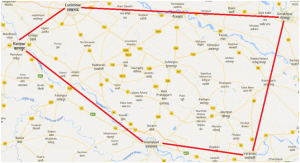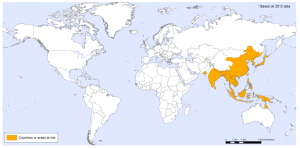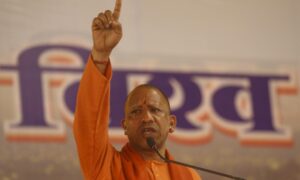
Today, India is celebrating its 71th Independence Day. The auspicious day has converted as a day for lofty promises and unreal pledges. In reality, we are completely failed to run our institutions efficiently. A Recent example is the Gorakhpur Tragedy where a huge number of Kids died in a government hospital because the administration failed to pay the oxygen supplier’s outstanding dues! All these kids were grappling with Japanese Encephalitis (JE). Before delving into the detail, there is a need to understand about this lethal disease. According to the World Health Organisation (WHO), the first case of Japanese encephalitis viral disease (JE) was documented in 1871 in Japan.
Japanese Encephalitis: Countries at Risk

Source: WHO
Japanese Encephalitis: Key Facts by WHO
- Japanese encephalitis virus (JEV) is a flavivirus related to dengue, yellow fever and West Nile viruses, and is spread by mosquitoes.
- JEV is the main cause of viral encephalitis in many countries of Asia with an estimated 68 000 clinical cases every year.
- Although symptomatic Japanese encephalitis (JE) is rare, the case-fatality rate among those with encephalitis can be as high as 30%. Permanent neurologic or psychiatric sequelae can occur in 30%–50% of those with encephalitis.
- 24 countries in the WHO South-East Asia and Western Pacific regions have endemic JEV transmission, exposing more than 3 billion people to risks of infection.
- There is no cure for the disease. Treatment is focused on relieving severe clinical signs and supporting the patient to overcome the infection.
Source: http://www.who.int/mediacentre/factsheets/fs386/en/
As the above-mentioned WHO Mapping shows that a large chunk of India is under the grip of JE. In the wake of Gorakhpur fiasco, Impact News is assessing various thorny issues which strangulated the health care system in Uttar Pradesh in India. What are operational challenges to run a public health care centre in India? What’s role of the government, the management and the doctors? What is ethics for a professional from the medical sector? Do we love to see the suffering of common people?
Gorakhpur is Trending after a Tragedy!

Google India Screenshot for Gorakhpur
If you’ll google Gorakhpur, instantly you’ll get search results like “Gorakhpur Tragedy”, “Gorakhpur Hospital Tragedy”…! It shows that how sudden deaths provoked people to search for more news related to it. People are shocked after a sheer negligence that caused several lives. In this backdrop, political slugfest escalated. They are desperate to visit the hospital site in Gorakhpur, Uttar Pradesh. Administratively, the Uttar Pradesh Government runs the hospital.
As we all know, Gorakhpur is a constituency of Yogi Adityanath- the Chief Minister of Uttar Pradesh. As Mahanth of Gorakh Dham, Adityanath contested from Gorakhpur and undisputedly elected for several terms. Aditya Nath was notorious for his remarks against Muslims in order to mobile the vote bank. After a landslide victory in Uttar Pradesh, the Bhartiya Janata Party (BJP) picked him to run the state government and his selection surprised many people in India.
Without having much experience in administration, Yogi assumed the office in a politically charged state. Before delving into the detail, there is a need to understand the healthcare system in Uttar Pradesh. Gorakhpur is a religious city which is very close to Bihar and Nepal. It is surrounded by various districts which are relatively poor and agrarian. There is a sheer lack of a good hospital in all adjoining districts so they prefer to admit patients in Gorakhpur. Despite the economic hardship, they stay in various hospitals in the city.
A couple of years back, Uttar Pradesh witnessed a massive scam in a centrally sponsored scheme when Mayawati was chief minister. The central investigating agencies nabbed many accused but the situation is almost same. The public health care system is ailing and tattered. There is an apparent trend of the gross root privatisation. Jhola Chaap Doctors are everywhere; they are thriving and expanding in an absence of state capacity. Sadly, there is no regulation to tame such fraudulent doctors.
As we all know, Uttar Pradesh is, demographically, the largest state in India where every political party tries to cement their positions for the vote bank. Despite its size, the well-equipped health centres are based only in Varanasi, Lucknow, Allahabad, Kanpur and Gorakhpur. Many of such centres are unaffordable for marginal farmers, manual labourers, women and other vulnerable groups.
After severe health complications, people come to these centres where they grapple with an enormous crowd and chaos. With help from various kinds of networks, they try to enter or admit their patients. People who have no contacts and connections, they are forced to remain (linger on) near the hospitals. Many times, the hospital authorities deny admitting them. The public healthcare system is almost crumbled and unresponsive where the private centres are unaffordable. At this juncture, we don’t need a new India what we need is an India with functional institutions where the hospital administration can pay dues to vendors on time so we can save the kids.


















